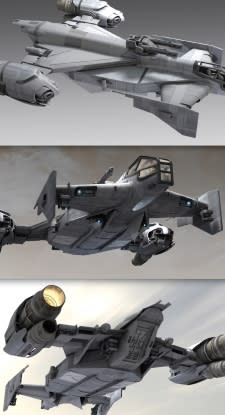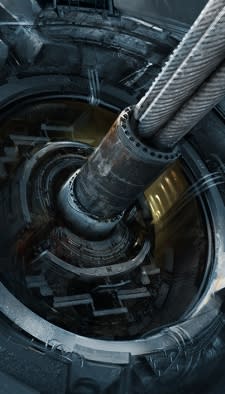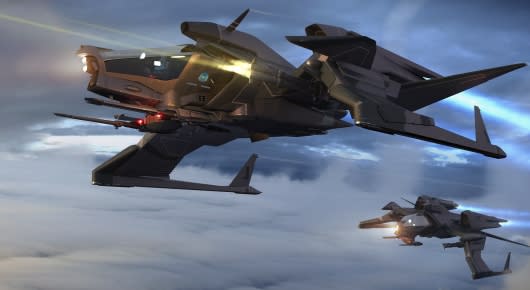PAX East 2014: Erin Roberts on Star Citizen's development
Star Citizen's backers have been waiting to see the game's dogfighting module in action for quite some time now, and it finally happened just before PAX East 2014. Unfortunately, it also wound up having some technical difficulties right at the beginning, which wasn't exactly what anyone had in mind when showing off the whole thing in action. It wasn't quite as bad as having the computer running the module burst into flames and die, but it was bad.
Do the developers regret it? Not a chance. We got a chance to sit down and talk to Squadron 42 producer Erin Roberts and were told, in no uncertain terms, that even hitting technical hiccups like that don't make a more private development cycle feel better. In a way, having the development cycle be so public actually makes technical hurdles less problematic for the company when they're encountered because the language is in place to keep a meaningful dialogue going with the fans.

Roberts explained that when you're working on a title for a larger publisher, there's a constant need to be concerned about the message being conveyed for every given release. The transparency between players and developers doesn't exist. If you as a developer try to run a demo and something goes wrong, there's a major disconnect and it turns into a huge debacle.
By contrast, fans of Cloud Imperium Games are able to look at what happens and then realize that it's just a technical error that can crop up, no more than a minor misstep. There's no concern over the message, just a joy in working on a game that fans want and one that can be shown off as parts get completed rather than hiding everything behind a thick veil of obfuscating language. A disaster for a larger publisher isn't a problem for Cloud Imperium.
It's also a chance for the development team to interact more with the community and share some of the reality of the development process. With so much money raised via crowdfunding for an as-yet unproven studio, there's always going to be some observers who think that the whole game is just a successful scam. Keeping more open lines with the community makes it clear what work is being done on the game, what improvements are being rolled out, and so forth. It's important for backers and onlookers alike to see the game for what it is as well as what it can be and will be.
Moreover, Roberts argued, the game's community is a big part of what draws players in and keeps them engaged. By and large, the people rallying around the game have proven to be mature and understanding about the development, a blessing for any game and a welcome boon to the developers.
So with the dogfighting module being both the portion on display as well as the most delayed element of the game to date, what about it has proven so challenging? As it turns out, everything. Getting the backend to work properly alone has been a huge undertaking; getting the ships working properly, getting the physics working properly, ensuring that every part of the detailed and intricate ships work with the damage systems... none of it was the easy part. There isn't one obvious element that held the module back, says Robert; there are many.
Of course, there's room to worry that many of the game's modules may turn out like this, that more features will keep getting added and the development will slow as more things get added like a game-based version of Zeno's Paradox. But Roberts stresses that the plan for the overall design spec hasn't changed much since the beginning, that all that's being added is more fidelity and detail in the various elements. The modules are about releasing iterative improvements and expansions, not about welding something new to the game that hadn't originally been planned.

Squadron 42 is currently on track for a release in Q1 2015, for instance, and the biggest issue in getting it finalized is simply about getting the pieces together. It's a matter of making sure all of the various components like capital ships and such work properly, as they're all going to be part of the persistent universe afterward. That means it's slightly slower to put them together, but it also means that once things are created, they're usable forever in a wider range of applications.
Squadrin 42 isn't hampering the game's overall development, either. Making one element work better makes everything work better. Squadron 42 will be released in five parts, with the last part corresponding to a step upward in the development on the persistent universe, the intent being that it essentially will introduce players to the details of Star Citizen overall. What works on the smaller stage will still work just fine when everything expands.
And the end goal, from there, is to make a game that everyone invested will be able to still play a decade from now. Roberts hopes it'll be a universe to expand and explore for the long haul.
Working on the game is a passion for the development team, a team that genuinely wants to make the game. It's not a matter of just arbitrarily working on a title but of a game that the people in charge have always wanted to play. Now is the time when the technology and people are in the right place to start making it into a reality, and if it's your sort of game, there's every reason to be excited as it moves ever closer to release.
No promise about never experiencing technical glitches of your own here and there, though.

Massively was on the ground in Boston during the weekend of April 11th to 13th, bringing you all the best news from PAX East 2014. Whether you're dying to know more about WildStar, Landmark, or any MMO in between, we aim to have it covered!


